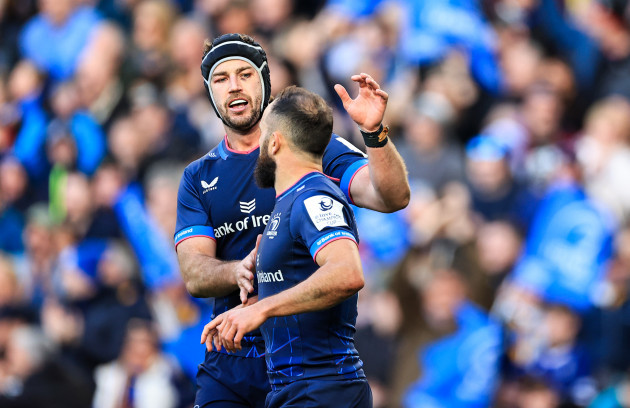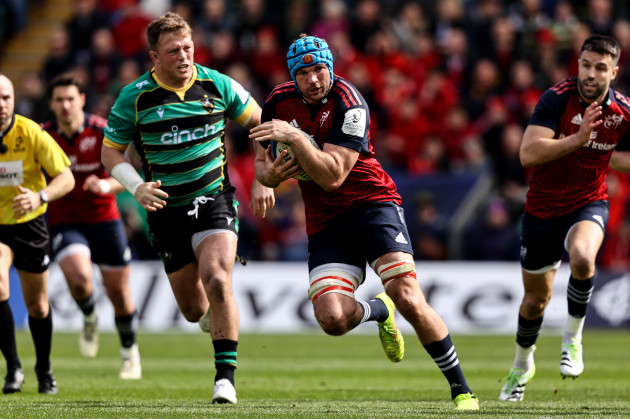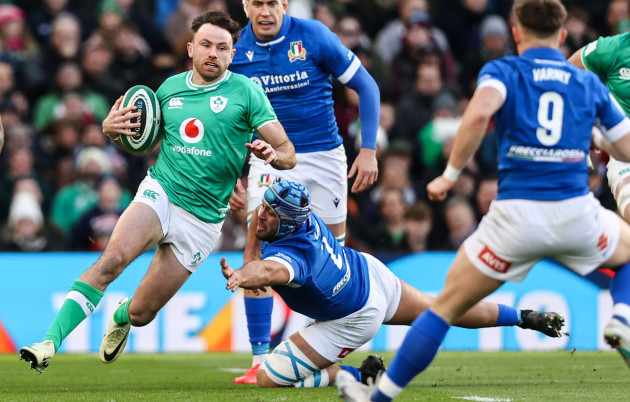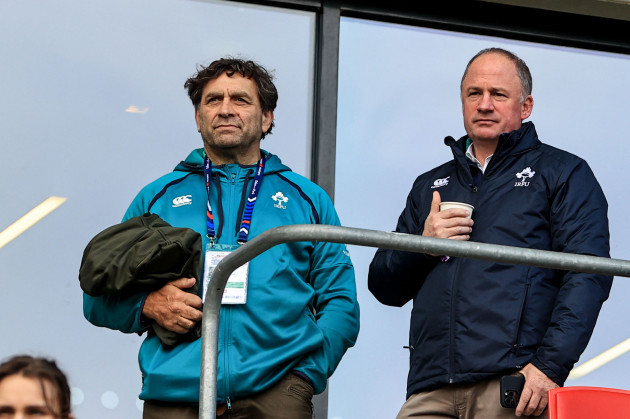AFTER A WEEK in which plenty of us ventured the opinion that Irish rugby’s contracting system and financial model could do with a review, it turns out the IRFU has already done it.
The union launched an independent review last year and as a result, there could be a tweak to the ‘national contracts’ system as early as next season which would essentially see provinces contributing financially to national contracts for the first time.
Commonly referred to as ‘central contracts,’ these are the deals in which the leading players in the country have their salary paid in full by the IRFU, meaning their province doesn’t have to contribute any of their own budget towards that player.
This has been topical this week because confirmation that Dan Sheehan has signed an IRFU national contract and news that Jamison Gibson-Park is set to go onto a national deal next season, as first reported by the Irish Times, means Leinster are set to have 10 players on national contracts. As things stand, Munster, Ulster, and Connacht will have just one apiece for the 2024/25 campaign.
Having 10 players on national IRFU contracts means Leinster get plenty of wiggle room in their player budget, which is partly why they can sign Jordie Barrett and RG Snyman, while they continue to look for a new signing at tighthead prop. That budgetary breathing room also allows Leinster to maintain a deep squad of high-quality homegrown players.
Leinster deserve huge credit for developing players to a national contract level. They’re the bulk suppliers to the Ireland team, the side that generates 80% of the income in Irish rugby. Without a strong Ireland team, the entirety of Irish rugby would be in trouble.
And yet, it’s not ideal that one province gets such a clear benefit from having so many national deals. Before going any further, it’s worth pointing out that the IRFU is literally made up of the four provinces, with each of them represented on the union’s board.
They have discussed national contracts many times in recent decades and have voted to stick with the system on several occasions. Back in the early 2010s, there were more than 25 national contracts at times, with Munster and Leinster contributing fairly even numbers of players as Connacht and Ulster also chipped in.
That number of national contracts has reduced in the years since down to the current status quo of around 12 to 15 depending on the specific season.
But the situation next season with 10 in Leinster and a combined three elsewhere is imperfect and after the review launched last year, it seems change is on the way.
It’s understood that under the proposed tweak, a province would essentially contribute a certain percentage of a nationally-contracted player’s salary to a central pot of funds. That pot would then be evenly distributed among all of the provinces. It doesn’t sound like an agreement has been reached on exactly what that percentage would be.
This tweak would mean that the major bulk of a player’s national contract would still be off the province’s budget, rewarding them for delivering that player to an elite level, but also somewhat reducing the advantage Leinster have with 10 nationally-contracted players.
No one in Irish rugby seems to have an issue with what Leinster are doing and everyone recognises that they are maximising the strengths that exist within the eastern province. They’re harnessing the quality of players produced in the Leinster schools system by repeatedly backing homegrown products and investing in world-class coaching. They lead the way in turning talent into top-end ability.
Commercially, Leinster have worked hard to grow revenue – particularly by building their season ticket holder base, moving certain home games to the Aviva Stadium, and attracting some private investment – meaning their financial situation is stronger than the other three provinces.
The concern, though, is that Leinster could pull completely away from the pack. There is no sense within Irish rugby that anyone wants to slow Leinster down in their growth, and the province themselves have huge ambition, but there does seem to be a hope that the chasing provinces can make up ground.
It should be said that the current gap may be exaggerated at times. Munster are the only province in Ireland who are trophy holders right now. Leinster last won silverware in 2021, although they appear to be in good shape this season and next season to challenge for both the URC and Champions Cup. And the signs of them opening up a bigger gap can’t be ignored.
The ideal scenario for the IRFU would be that the other three provinces start delivering more players who can genuinely compete for national contracts. That’s partly why this system was devised – to incentivise the provinces to produce players of that level.
And it should be pointed out that Munster, Ulster, and Connacht are working hard to do this. Take the example of Munster, who have had a strongly renewed focus on homegrown players in the last couple of seasons after a previously barren period, with exciting results. The southern province have been investing heavily in their pathways to obvious effect and while it may be another four or five years before that’s fully reflected at international level, the direction is right.
Munster duo Conor Murray and Peter O’Mahony, the current Ireland captain, are coming off national contracts at the end of this season, although their new one-year Munster provincial deals will be nearly half-funded by the IRFU.
While that agreement was hatched to help Munster absorb two players who have been on national deals for a long time back into their provincial budget, it should be noted that such top-ups from the IRFU are part of the contracting system anyway.
The union has a programme for Players of National Interest [PONIs], as first reported by the Irish Examiner, which is self-explanatory. This is for players who are part of Andy Farrell’s plans but haven’t yet earned a full national deal. PONIs have their provincial contracts topped up by the IRFU, meaning the provinces don’t have to break their budget in order to avoid that player’s head being turned by a club abroad.
So if there’s a player who you think absolutely should be on an IRFU national contract, there’s a strong chance they’re already on a PONI deal. In some cases, those PONI contracts might not even be far off what a national contract would be worth.
The IRFU have seen this as a way of trying to avoid that gap opening between Leinster and the other provinces, but it’s far from the case that the union has been handing out cash willy-nilly.
The reality in Irish rugby is that every single player in the country is centrally-contracted to the IRFU. It’s just that those on specific national contracts have been coming completely off their province’s budget.
The union provides Leinster, Connacht, Munster, and Ulster with an equal provincial contracting budget but the difference is that some provinces can generate more of their own revenue than others to supplement their budget. The IRFU also directly fund all academy contracts in the four provinces.
Leinster currently list 44 players in their senior squad, with 18 in the academy. Connacht have 45 senior players and 15 in the academy. Ulster are at 43 in the senior group and another 18 academy prospects. Munster currently have 41 senior players and 18 in the academy. So there are plenty of mouths to feed.
Munster, Ulster, and Connacht struggle to generate as much of their own revenue as Leinster but, again, they’re trying to come up with solutions.
Munster, for example, have started running dinners abroad in cities like New York and London, as well as hosting concerts at Thomond Park, and trying to secure games against high-profile touring teams.
Connacht, meanwhile, have launched the redevelopment of Dexcom Stadium in Galway. A bigger home venue obviously means being able to bring in bigger crowds and more money in the long-term. Every avenue needs to be explored if the provinces are to compete for URC and Champions Cup titles.
The national contracts system might be set for a tweak but the IRFU appears to be happy with how it has contributed to Ireland’s current standing in men’s Test rugby. It’s worth reiterating that 80% of the money that feeds the entire Irish rugby system at all levels, not just the professional game, comes from the national men’s team. So the IRFU’s primary focus is on Ireland being successful.
The best players go onto national deals, an obvious incentive and reward for being among the elite. These contracts are a key tool in deterring players from looking abroad, which seems to be less and less the case. There are fewer rumours of high-profile Irish players possibly moving abroad than ever.
They want to stay at home. Ireland has a relatively small player base but they’re well-managed in a physical sense, playing fewer games here than they would with a move to, say, France.
There’s also the 10-year tax benefit that applies to sportspeople in Ireland. This means retired players can claim a repayment of tax for a 10-year period during their career.
It will be intriguing to see how the proposed tweak to the national contracts system works and whether the redistribution of the central pot, to which Leinster will obviously contribute heavily, makes much of a dent.
The worry in other provinces seems to be that it might not be enough to prevent Leinster from pulling further away. The huge advantage of the Leinster Schools system is hard to overlook in this sense. The biggest schools in Leinster benefit from generous private donations towards their rugby budgets and if you combined all of those budgets, you’d be talking about millions of euros.
That’s money Leinster don’t have to spend themselves, even if they do an excellent job of supporting player and coach development. Leinster also have a far bigger population base, some of it very wealthy, to draw on when it comes to generating revenue.
The other three provinces might wonder whether they can ever consistently compete with that reality. They may feel that the IRFU should give them greater financial leeway to try to compensate or adjust for the differences, that dispensation for an extra non-Irish-qualified player here or there would help.
But managing to get more national contracts is crucial to the other provinces, meaning they would get more space in their provincial budget to strengthen their squads.
In the short-term, the outlook is not too encouraging. Next season, the national contracts list of 13 is set to be made up as follows:
Leinster – Caelan Doris [contract expires 2027], Hugo Keenan [2026], Dan Sheehan [2026], Josh van der Flier [2026], Jamison Gibson-Park [TBC], Andrew Porter [2025], Tadhg Furlong [2025], James Ryan [2025], Robbie Henshaw [2025], Garry Ringrose [2025].
Munster – Tadhg Beirne [2025]
Connacht – Bundee Aki [2025]
Ulster – Iain Henderson [2025]
Having taken over as Ireland’s starting out-half, Munster man Jack Crowley could be a candidate when his current provincial deal expires in 2025.
Connacht wing Mack Hansen, surely already on a PONI deal, is up for renewal in 2025 and will be in contention for a national contract at that stage.
From an Ulster point of view, Henderson’s current national contract expires in 2025 and he hasn’t been a guaranteed starter for Ireland in recent seasons. It’s not easy to pick out another player from Ulster who could be pushing for a national deal soon.
Aki’s national deal expires in 2025. He’s playing the best rugby of his career and though he turned 34 this month, he shows few signs of slowing down. Connacht deserve credit for producing Henshaw and will hope to turn out someone of his calibre again and keep them long-term.
The reality is that there are likely to be more Leinster players pushing in the near future. 23-year-old lock Joe McCarthy is making great strides at the moment. Ireland left wing James Lowe is not on a full national contract.
IRFU performance director David Nucifora has been responsible for green-lighting national deals since taking on his role in 2014, but he will soon be succeeded by David Humphreys.
Humphreys knows this system well, having worked in Ulster for so long, and it will be fascinating to see how he drives things on when he formally gets going in June.





